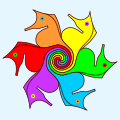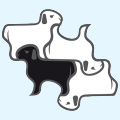Tessellation Symmetries – Introduction
Seeing the variety in tessellation artworks it’s natural to wonder about their underlying structure. We might notice for example that tiles in different artworks have different amounts of rotation, or a different number of neighboring tiles, or that sometimes tiles are flipped.
In fact, 35 different tessellation symmetries underlie the artworks on this site — all with these properties:
- A single tile shape, forming a recognizable figure
- Translational symmetry — you can slide the entire pattern in a straight line and end up with an identical pattern
- All tile edges are shapeable — no edge needs to be straight because the adjacent tile is a mirror image
(Mathematicians use the term isohedral for a tessellation with properties 1 and 2 — one tile shape, and translational symmetry.)
To understand the symmetries behind the artworks, please see these pages:
- Tutorial - How artistic tessellations work, step-by-step
- Diagrams & Art - A page for each symmetry, with a live diagram and example artworks
- Classification - Systems for organizing tessellation symmetries
- Summary Table - The 35 symmetries and their properties
And finally, some links for exploring other interesting worlds of tessellation art.

